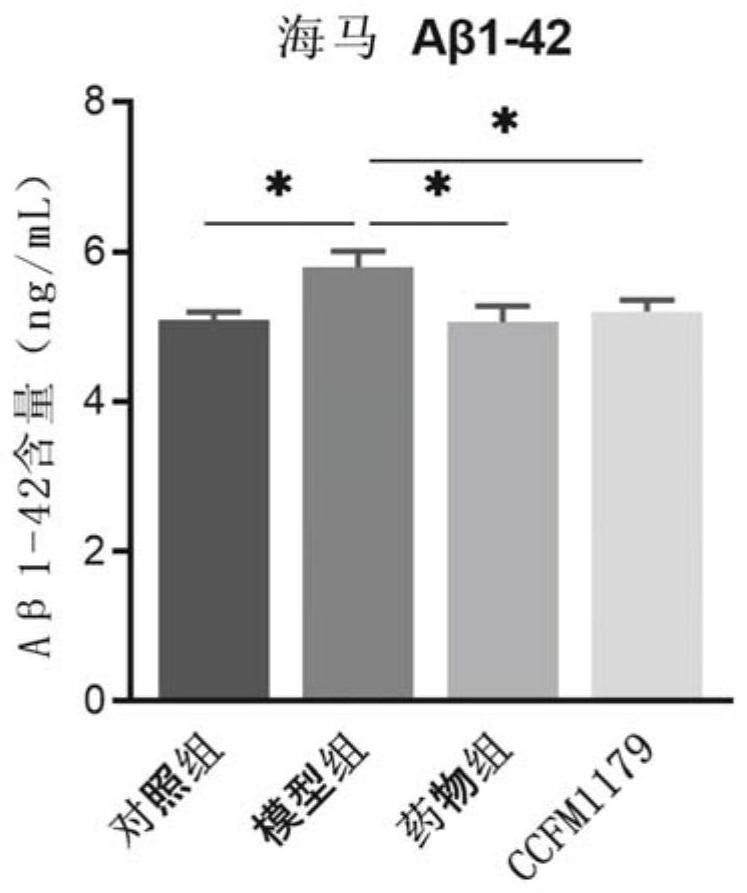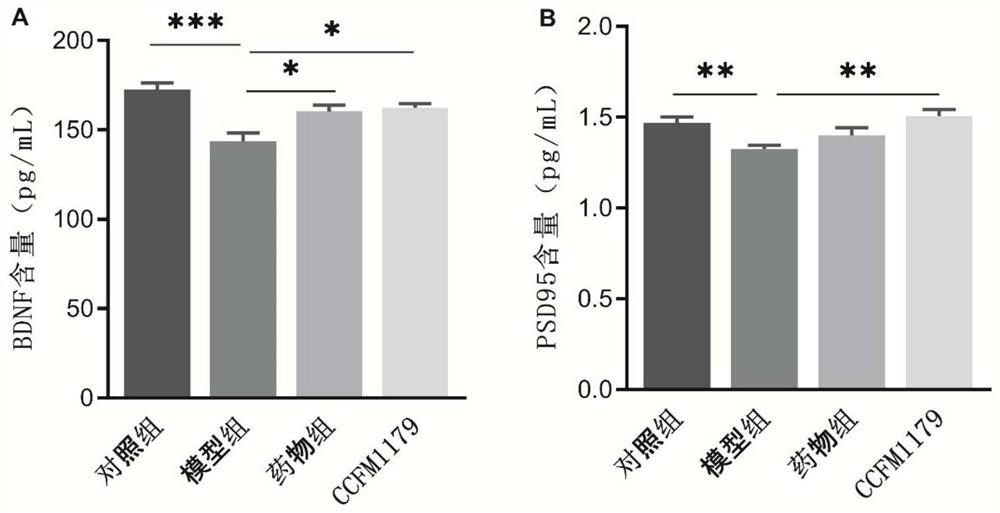Bifidobacterium breve capable of relieving Alzheimer's disease and increasing fecal acetic acid content and application thereof
A technology of Bifidobacterium breve and bacterial agent, applied in the field of microorganisms, can solve the problems of complex research methods of intestinal flora, lack of types of psychoactive probiotics, and few clinical studies of intestinal flora, etc., and improve the degree of species diversity. , improve the relative abundance, improve the effect of cognitive impairment
- Summary
- Abstract
- Description
- Claims
- Application Information
AI Technical Summary
Problems solved by technology
Method used
Image
Examples
Embodiment 1
[0049] Screening and Identification of Example 1 Bifidobacterium breve CCFM1179
[0050] (1) Isolation and screening of bacterial strains:
[0051] (1) Use a disposable aseptic toilet to collect the feces of a 10-month-old male infant who is exclusively breastfed in Wuxi City, Jiangsu Province, and the feces samples are contained in the MRS+ mass percentage (0.05%-0.1%) of fructooligosaccharides. Cysteine medium, in an anaerobic incubator (N 2 :CO 2 :H 2 =80:10:10) enriched for 12h;
[0052] (2) The feces samples were serially diluted with sterile saline, and then spread on the MRS+ mass percentage (0.05%-0.1%) L- On the solid plate of cysteine hydrochloride, cultivate for 24-48h;
[0053] (3) Select a single colony conforming to the basic form of bifidobacteria to carry out streaking and purification on the plate, and screen and isolate the selected bacterial strain;
[0054] (4) The above-mentioned single colonies were cultured in liquid MRS+mass percentage (0.05%-...
Embodiment 2
[0076] Example 2 Bifidobacterium breve CCFM1179 improves the behavioral indicators of Alzheimer's disease mice
[0077] Thirty-two 7-week-old male C57BL / 6J mice were taken, and after one week of adaptation to the environment, the animal model of Alzheimer's disease was established by one-time microinjection of Aβ1-42 protein into the hippocampus of the brain. Divided into four groups: control group (injection of equal volume of normal saline), model group, drug intervention group, CCFM1179 intervention group, each group contains 8 mice. The animal groups and treatment methods are shown in Table 1.
[0078] Table 1 Grouping and processing methods of animal experiments
[0079]
[0080]AD mouse model induced by microinjection of Aβ1-42 protein in the brain: After the mice were adapted for one week, the mice in each group were anesthetized with isoflurane (induction concentration 3%, maintenance concentration 1%), and the hair on the top of the mice was removed. After disinf...
Embodiment 3
[0093] Example 3 CCFM1179 reduces Aβ protein deposition in the brain of Alzheimer's disease mice
[0094] The mouse grouping, modeling and treatment methods are the same as in Example 2. After the mouse behavior experiment, the next day, the mice were injected intraperitoneally with 1% pentobarbital sodium solution to make them anesthetized, and the mice were killed. The brain tissue of the mice was taken and separated on ice. Hippocampus. Take a certain quality of fresh hippocampus tissue, add 9 times the volume of sterile PBS buffer solution (equivalent to 1g tissue plus 9ml homogenate), homogenize with a tissue homogenizer, and take the supernatant after the tissue fluid is centrifuged at 3000g for 15min. The content of Aβ1-42 in the hippocampus was detected by ELISA kit.
[0095] Experimental results such as figure 2 As shown, the results show that the intervention of Bifidobacterium breve CCFM1179 can significantly reduce the deposition of Aβ1-42 protein in the hippoc...
PUM
| Property | Measurement | Unit |
|---|---|---|
| Bacteria | aaaaa | aaaaa |
| Bacteria | aaaaa | aaaaa |
Abstract
Description
Claims
Application Information
 Login to View More
Login to View More - R&D
- Intellectual Property
- Life Sciences
- Materials
- Tech Scout
- Unparalleled Data Quality
- Higher Quality Content
- 60% Fewer Hallucinations
Browse by: Latest US Patents, China's latest patents, Technical Efficacy Thesaurus, Application Domain, Technology Topic, Popular Technical Reports.
© 2025 PatSnap. All rights reserved.Legal|Privacy policy|Modern Slavery Act Transparency Statement|Sitemap|About US| Contact US: help@patsnap.com



